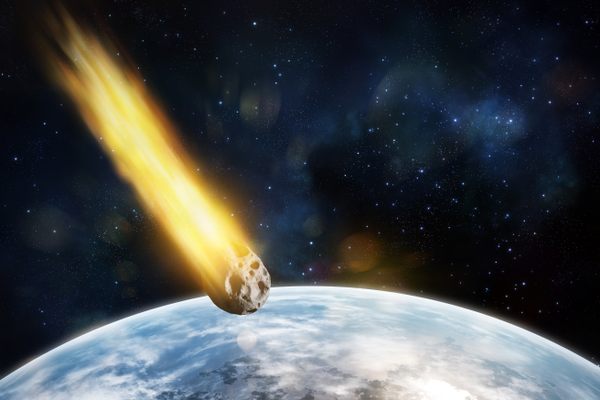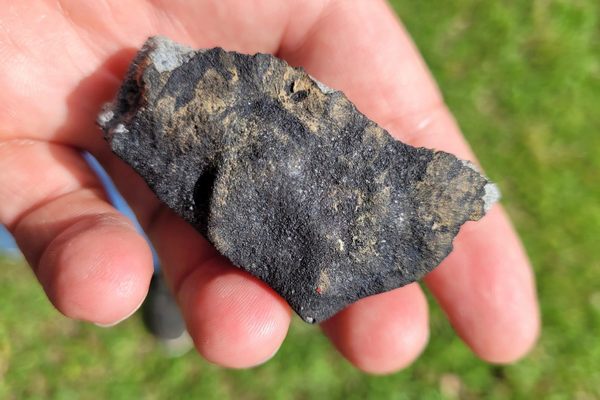How the Britpop Legends Blur Almost Launched the U.K. Space Program
What started as a late-night chat transformed into millions of dollars of funding for a Mars lander.
Secret Obsessions is Atlas Obscura’s new column where we ask wondrous people to take us down a rabbit hole. This edition features the drummer of the British band Blur, Dave Rowntree, as told to Associate Editor Sarah Durn.
I got my first telescope for Christmas when I was nine or 10. Growing up, I would spend hours and hours out in the back garden, staring up at the stars and planets in the shadow of our very conventional two-up, two-down, semi-detached house in Colchester, some 50 miles northeast of London. I would stick it out for as long as I could, until I got so cold that I had to come in. Ever since I’ve always had a telescope.
As I got older, I still carried on looking through telescopes, but the band started taking off in the 1990s, so that took up most of my time. Once I was on tour with Blur in the United States. We had just played in Texas and had a day off in Houston. Most of the band went off and did something else, but Alex James, the bass player who’s also interested in astronomy, and I decided to go to the space center.
We were struck by how many of the people we met were from Europe, specifically from the United Kingdom. That night, we stayed up very late, and the later we stayed up, the more of a good idea it seemed to be to start the U.K. space program ourselves. So we thought we’d ring up our accountant and get him to put that in action. Of course, he was asleep in bed, and he used some language that really shocked me to this very day. I didn’t know accountants were allowed to use that kind of language.
Anyway, the next day he rang us back when we were asleep and let us know how much he appreciated being called at six in the morning by these two idiots. Then he said, “However, funny you should mention a U.K. space program, because a new neighbor just moved in next door and I was chatting to him over the garden fence the other day and I asked him what he did and he said he builds satellites. If you want to talk about British space research, why don’t you go and talk to him?”
So we talked to our accountant’s neighbor and told him our grand plan. I felt it was rather rude how loudly and for how long he laughed at that idea, but when he calmed down, he said, “No. But funny you should say that because I was in the queue at the canteen the other day and the guy in front of me is the head of planetary science at the Open University and he actually has got a plan to start the British space program, but he needs some money. Why don’t you go and talk to him?”

So two meetings later, we were at one of the Open University’s lecture theaters when planetary scientist Colin Pillinger walked in. He sat down with us, and out of his pocket, he pulled a little plastic container with a small rock in it. He said, “You know what that is? That’s a piece of Mars. A big meteorite hit Mars, threw millions of tons of rock out into space, and those pieces drifted around until some had landed on Earth.
“However, the same thing has happened in reverse. Asteroids and meteorites have hit the Earth millions of times and pieces have been thrown off into space. And wherever we’ve looked on Earth, even in the most seemingly inhospitable places, we have found life. So even in the hard, cold reaches of space, there’s no reason to assume that some bacteria can’t survive. So if we do find life on Mars, maybe it came from Earth. Even more interestingly, maybe life on Earth came from Mars. Who knows?”
The European Space Agency had a mission going to Mars called Mars Express, but they had some mass left over on the spacecraft. So Colin had designed an entire Martian lander, complete with a battery of experiments, all of which were looking for signs of life on Mars, to fit in this tiny space on the spacecraft. But he still had to build the thing—and it was going to cost £25 million.
“Are you in?” he said. So, by that point, our mouths were on the floor, and of course we readily, hook-line-and-sinker, agreed to get involved.
From that point, in every interview that either Alex or I did, when a journalist said, “Why did you call your album blah-blah-blah?” We said, “We don’t want to talk about that. There’s this guy Colin Pillinger and he’s got a plan to go to Mars.” We just told the story again and again to anyone who would listen.
Colin suggested that Alex and I might persuade the rest of the band to write a call sign for the Beagle 2, the name of the lander. If the lander made it to Mars and all the systems were working, the first thing it would do is beam this signal back to Earth. We’d get to play the first gig on Mars. It was an easy sell.

We were also friends with the artist Damien Hirst. So Colin said, “Why doesn’t Damien do a spot painting, which he was famous for at the time, and that can be the calibration image for the lander’s cameras? Then Damien will have sent the first artwork to Mars.” Of course, he was very happy about that and that’s exactly what he did.
Then Colin managed to get lots of different British companies to build different parts of the lander. Martin-Baker, which makes ejection seats for fighter aircraft, was going to build the descent parachutes. McLaren, which makes Formula 1 cars, agreed to build the shell of the spacecraft out of carbon fiber. The government had agreed that they would match every pound he raised, and so in the end he got the money.
Then, on June 2, 2003, Beagle 2 launched into space. We went to mission control in Leicester. They had a satellite feed up on the big screen from Baikonur Cosmodrome in southern Kazakhstan, where the spacecraft was being launched. They had a camera actually on the side of the rocket itself, and you could see the Earth receding into the distance. The launch went without a hitch, and there was lots of cheering and jumping up and down and hugging.
It took six months for the spacecraft to actually reach Mars. In December, we watched as Beagle 2 exploded off of the main spacecraft. At that point, we knew the lander would reach Mars, but there was no way of knowing if it was going to be a soft, feathery landing or a massive, Martian explosion. We had a wait until our little tune would play.
We knew Christmas Day would be the earliest possible opportunity for the lander to send its signal home. So I had my Christmas meal at home and then camped out at the Open University. Television cameras from all over the world were there and we just sat there waiting. Unfortunately, we heard nothing. And after three days, we still hadn’t heard anything, which meant something had gone wrong.
Colin had said early on, when we got involved, that no country had ever landed on Mars on its first attempt. It’s an unimaginably difficult thing to do. There were a million things that had to go right. We felt so tantalizingly close to sticking the landing, executing the experiments, playing our gig on Mars, and having Damien’s spot painting calibrate the cameras. All of that would have made history. But it didn’t work and we had no idea what had become of our little space art and science project.

Then, in 2015, NASA was doing a high-resolution, photographic mosaic of the entire surface of Mars. And they found Beagle 2 safely on the surface. It was so sad because Colin had died of multiple sclerosis in the intervening years, so he never got to see it. The lander actually had made it, but its solar panels hadn’t properly deployed. Colin had always known that was a risk. It didn’t have the power to send the call sign back or use its cameras, but it had made it.
Bizarrely enough, I’m now doing a degree in astronomy at the Open University, which is where Colin used to teach. I’m doing it part-time so it’ll take years to finish, but I’m hoping along the way I can find some interesting research project and contribute something of value to the community—that’s my dream.
I just bought a new telescope, and right now the view of Mars is as good as it’s going to be for a decade. After Beagle 2, Mars is my planet, really, and whenever I look at it I always imagine our little lander up there somewhere, hanging out the surface, our little piece of music somewhere in its memory.
Dave Rowntree achieved stardom as the drummer of Blur, one of the quintessential Britpop groups of the 1990s. Rowntree anchored the band throughout an eventful decade as one of the most popular bands in Britain, then chose to pursue a variety of interests following the group’s separation in the mid-2000s. He worked in computer animation, directed the television show Empire Square, spent some time as a radio broadcaster, and became a solicitor, before eventually pursuing a political career as a Labour Party candidate. Rowntree maintained a connection to music by composing film scores and Blur reunions, but he didn’t launch a solo career until 2023, when he released his debut album, Radio Songs.
















Follow us on Twitter to get the latest on the world's hidden wonders.
Like us on Facebook to get the latest on the world's hidden wonders.
Follow us on Twitter Like us on Facebook